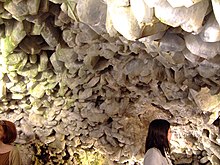Celestine (mineral)
| Celestine | |
|---|---|
 Clear grey-blue celestine crystal crust from Madagascar | |
| General | |
| Category | Sulfate minerals |
| Formula (repeating unit) | SrSO4 sometimes contains minor calcium and/or barium |
| Strunz classification | 07.AD.35 |
| Crystal system | Orthorhombic |
| Space group | Orthorhombic 2/m 2/m 2/m dipyramidal |
| Unit cell | a = 8.359 Å, b = 5.352 Å, c = 6.866 Å; Z = 4 |
| Identification | |
| Color | Colorless, white, pale blue, pink, pale green, pale brown, black |
| Crystal habit | Tabular to pyramidal crystals, also fibrous, lamellar, earthy, massive granular |
| Cleavage | Perfect on {001}, good on {210}, poor on {010} |
| Fracture | Uneven |
| Tenacity | Brittle |
| Mohs scale hardness | 3 - 3.5 |
| Luster | Vitreous, pearly on cleavages |
| Streak | white |
| Diaphaneity | Transparent to translucent |
| Specific gravity | 3.95 - 3.97 |
| Optical properties | Biaxial (+) |
| Refractive index | nα = 1.619 - 1.622 nβ = 1.622 - 1.624 nγ = 1.630 - 1.632 |
| Birefringence | δ = 0.011 |
| Pleochroism | Weak |
| 2V angle | Measured: 50° to 51° |
| Dispersion | Moderate r < v |
| Ultraviolet fluorescence | Short UV=yellow, white blue, long UV=yellow, white blue |
| References | [1][2][3] |
Celestine or celestite[4] (SrSO4) is a mineral consisting of strontium sulfate. The mineral is named for its occasional delicate blue color. Celestine is the principal source of the element strontium, commonly used in fireworks and in various metal alloys.
Occurrence


Celestine occurs as crystals, and also in compact massive and fibrous forms. It is mostly found in sedimentary rocks, often associated with the minerals gypsum, anhydrite, and halite.
The mineral is found worldwide, usually in small quantities. Pale blue crystal specimens are found in Madagascar.
The skeletons of the protozoan Acantharea are made of celestine, unlike those of other radiolarians which are made of silica.
In carbonate marine sediments, burial dissolution is a recognised mechanism of celestine precipitation.[5]
It is sometimes used as a gemstone.[6]
Geodes


Celestine crystals are found in some geodes. The world's largest known geode, a celestine geode 35 feet (10.7 m) in diameter at its widest point, is located near the village of Put-in-Bay, Ohio, on South Bass Island in Lake Erie. The geode has been converted into a viewing cave, Crystal Cave, with the crystals which once composed the floor of the geode removed. The geode has celestine crystals as wide as 18 inches (46 cm) across, estimated to weigh up to 300 pounds (135 kg) each.
See also
References
- ^ Handbook of Mineralogy
- ^ Mindat.org
- ^ Webmineral data
- ^ Nickel, Ernie.; Nichols, Monte. Mineral Names, Redefinitions & Discreditations Passed by the CNMMN of the IMA Archived 2008-05-30 at the Wayback Machine, Materials Data, 2004, p. 26. Celestine is the approved name for this mineral by the International Mineralogical Association Commission on New Minerals and Mineral Names (CNMMN). Although celestite finds frequent usage in some mineralogical texts, the name has been discredited as a valid mineral name by this organization.
- ^ Baker, Paul A.; Bloomer, Sherman H. (1988). "The origin of celestite in deep-sea carbonate sediments". Geochimica et Cosmochimica Acta. 52 (2): 335–339. Bibcode:1988GeCoA..52..335B. doi:10.1016/0016-7037(88)90088-9.
- ^ Tables of Gemstone Identification By Roger Dedeyne, Ivo Quintens p.174
External links
- . Encyclopædia Britannica. Vol. 5 (11th ed.). 1911.
